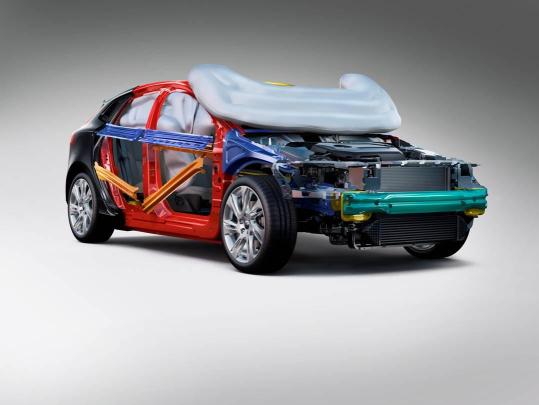
Volvo’s pedestrian protection system wins NCAP safety award
V40 – Deployed Pedestrian Airbag
Volvo’s pioneering work on pedestrian protection has been rewarded with the 2013 Global NCAP Innovation Award. The prize was received by Prof. Lotta Jakobsson, Senior Technical Specialist Safety at Volvo Cars Safety Centre, at the Enhanced Safety of Vehicles (ESV) Conference in Seoul, South Korea.
At the ESV Conference, Prof. Jakobsson presented a paper on the Pedestrian Airbag Technology in the new Volvo V40.
‘The purpose of the world’s first airbag for pedestrians is to help protect these vulnerable road users in certain situations when they impact the bonnet and the area around the windscreen, where there may be a risk of serious head injuries,’ she said.
In China, 25 per cent of traffic fatalities are pedestrians. In Europe, the figure is 14 per cent and in the USA 12 per cent, with many more being seriously injured, often due to the head impacting hard structures under the bonnet, the windscreen’s lower edge and the A-pillars.

Volvo’s Lotta Jakobsson, Senior Technical Specialist Safety
In 2010, Volvo Cars launched Pedestrian Detection with full auto brake which can prevent a collision with a pedestrian at speeds of up to 35 km/h if the driver does not respond in time. At higher speeds, the focus is on reducing the car’s speed as much as possible before the collision.
If a collision with a pedestrian is unavoidable, the Volvo V40, launched in 2012, comes equipped with the world’s first Pedestrian Airbag Technology.
Seven sensors embedded in the front of the car transmit signals to a control unit. When the car comes into contact with an object, the control unit evaluates the signals and if it registers a human-like leg form, the pedestrian airbag is deployed.

The Volvo V40 with deployed pedestrian airbag
The bonnet hinges are equipped with pyrotechnical release mechanisms which, when the system is activated, pull out a pin and release the rear of the bonnet. At the same time, the airbag is inflated. During the inflation sequence, the airbag raises the bonnet. It is lifted ten centimetres and stays in the raised position.
The added gap between the bonnet and the hard components in the engine compartment gives space for the bonnet to deform, absorbing energy and dampening the impact of the pedestrian’s head and chest.
‘The airbag has a dual function. It raises the bonnet to create distance. Then it helps to cushion the impact by covering the hard parts around the windscreen,’ explained Lotta Jakobsson.

V40 – Safety structure and air-bags deployed
In 2012, the all-new Volvo V40 achieved a five-star Euro NCAP rating and also won the Euro NCAP Best in Class in the Small Family class – with the best overall result ever recorded by the organisation. The V40 scored an all-time high in the pedestrian evaluation by attaining 88 per cent of the total score.
‘Several studies have documented that our collision-avoiding systems lead to significant accident reductions in real-life traffic. By continuously introducing new preventive and protective systems, we keep moving towards our aim that by 2020 no one should be injured or killed in a new Volvo,’ concluded Ms. Jakobsson.
- Introducing the Apple AirTag - July 20, 2023
- Slavish Thinking: غلامانہ سوچ - April 27, 2017
- Android is expected to welcome BBM before October - July 21, 2013


No Comments Yet